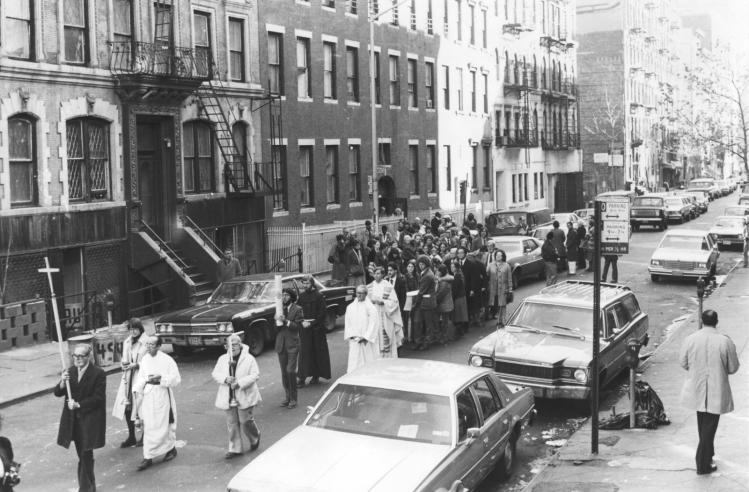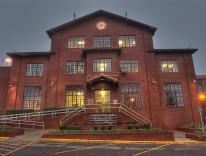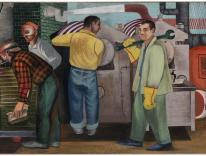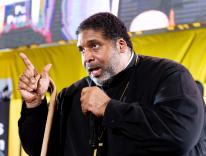
For the first two decades after her death in 1980, Dorothy Day was revered as a life guide mainly by devoted followers and fellow travelers. In their pastoral letter on nuclear weapons, The Challenge of Peace (1983), the U.S. Catholic bishops praised her pacifism but only as an individual witness; they did not recommend it for society at large. Catholic scholars commended her heroic service to the poor but criticized her theology as utopian and sectarian. After the end of the Cold War, when the “end of history” seemed to vindicate free-market economies and liberal democracy, her critique of capitalism and the state was deemed irrelevant. But a gradual shift has occurred in reckoning with her legacy, prodded by the most unlikely of authorities.
In 2000, Cardinal John J. O’Connor, Archbishop of New York and head of the U.S. Military Vicariate, initiated the cause for Day’s canonization. Friends and coworkers who knew her were consulted. A Dorothy Day guild was established. She was named “Servant of God.” Then in 2012, the U.S. Catholic bishops gave their unanimous approbation of Day’s cause and forwarded it to Rome. In 2015, Pope Francis stood before a joint session of Congress and extolled Day’s example of faith, devotion to the saints, and social activism rooted in the Gospel. More recently, her life and work have gained increased attention beyond Catholic circles. In 2016, the conservative New York Times columnist David Brooks included a chapter on Day in his bestselling book The Road to Character, extolling her persistent struggle for justice. This past January, the DVD version of the film by Martin Doblmeier, Revolution of the Heart: The Dorothy Day Story, hit the top spot for documentaries on the Amazon sales chart. In March, it was aired by PBS. And now we have a new full-length biography published by a major trade publishing house and intended for a general readership. There has never been so much attention focused on the matriarch of Catholic radicalism in the United States.
Dorothy Day would have been wary of all this adulation. We should be a little wary too. Whenever a radical, personalist, anarchist pacifist who is also a deeply traditional Catholic receives kudos from almost every quarter, then it is likely that some crucial element in the story, some key aspect of the person, is being neglected or suppressed. How many Catholic bishops who have approved Day’s cause really understand her Trotskyist views on state politics or her unswerving condemnation of usury? If David Brooks really got her pacifism, would he follow his chapter on Day with a chapter extolling the virtues of General George C. Marshall? Does Jim Wallis, who in the Doblmeier film talks about her as a religious progressive, truly appreciate her piety, which shaped every aspect of her being, as Michael Garvey once put it, “from her mantilla down to her rosary beads”?
To their credit, John Loughery and Blythe Randolph appreciate the quite complicated, seemingly conflicted life of Dorothy Day. At the outset, they state that compared to other women of the Left who have been the subject of recent biographies—Jane Addams, Margaret Sanger, Rosa Parks, Rachel Carson, and Jane Jacobs, among others—Day is “a more difficult figure to encompass.” For almost fifty years, she was “a great anomaly in American life: an orthodox Catholic and a political radical.” Her sharp criticisms of capitalism, U.S. foreign policy, the arms race, and war after war, combined with a deep skepticism toward modern liberalism, “put her profoundly at odds with much of both secular and religious thought in the United States.” It is difficult, they acknowledge, “to sort out the paradoxes of a woman as many-sided as Dorothy Day.”
Loughery and Randolph address Day’s “paradoxes” and “many sides” through what has become a familiar story. What is striking is how they place her life in fuller context, filling in some gaps in that story and adding many vivid details.
In the early chapters, they provide background on the Call, the socialist daily paper that gave Dorothy her first job, and the Masses, where, working with Leftist luminaries Floyd Dell and Max Eastman, “she was happily in the eye of the storm” before the feds shut it down in August 1917. Here we learn that her comrade Mike Gold’s name was actually a pseudonym he adopted in the 1920s to replace the original (Romanian) Itzok or Irwin Granich, that he and Dorothy shared political and literary interests, and that perhaps they were lovers, although this is not certain. We do know that Mike Gold’s mother did not approve of the relationship. After hosting Dorothy for a tense family dinner, she smashed the plates used by their Gentile guest.
We also learn about Lionel Moise, the hard-boiled newspaper man who awed a “cub reporter” at the Kansas City Star by the name of Ernest Hemingway, and who was an unapologetic womanizer. Dorothy fell for him, hard. Their tortuous relationship is presented in disconcerting detail: Dorothy’s self-subordination to him, her following him to Chicago, her pregnancy and abortion, her suicide attempt(s) back in New York, and her marriage on the rebound to Berkeley Tobey which took her to London, Paris, Rome, Capri, then back to Manhattan where “the Tobeys” lived in the New Yorker Hotel. Dorothy walked out on him shortly thereafter and headed back to Chicago—back, she hoped, to Lionel, but to no avail. After almost two years there, plus five months in New Orleans, she returned to Manhattan just as her novel, The Eleventh Virgin, was published. Loughery and Randolph describe the reviews as “soul flattening.” Nevertheless, the book was purchased for movie rights, allowing Dorothy to buy a bungalow on Staten Island.
Readers of Day’s autobiography, The Long Loneliness, might expect a dramatic shift in the plotline at this point, but Loughery and Randolph accentuate the continuity between Day’s life with Forster Batterham, the birth of her daughter Tamar, and her conversion, with her earlier period of “searching” (Part One of The Long Loneliness). They offer an informative background on the Batterham family of Asheville, North Carolina, and explain how Forster’s sister, Lily, whom Dorothy had befriended years before, introduced the two. As part of the Greenwich Village crowd, Forster acted in a Eugene O’Neill play at the Provincetown Playhouse. Dorothy loved his easygoing manner, his freedom from material attachments, his “unbribed soul,” as William James puts it in Varieties of Religious Experience, which Dorothy was reading at the time. The two were companionable, at ease with each other. For Dorothy, the relationship was a source of healing. It was strained by money trouble: Dorothy was a spender, Forster was exceedingly frugal. But it was the pregnancy that caused the breakup. Kids were not what Forster had bargained for. He did not even go to the hospital after Tamar’s birth. Dorothy’s decision the next year to have Tamar baptized made things worse. Her growing religiosity deepened the rift. After “a final, fierce argument” at Christmas 1927, Dorothy herself got baptized. But it was not a final parting, strictly speaking. Letters that were published in 2010 indicate that the relationship continued on and off for another five years—another period of searching, one could say, as Day tried to win Forster back. The authors depict these years too in rich detail: Day’s time in Culver City editing for a film studio, in Mexico City as a freelance writer, in Florida visiting her mother, all with Tamar in tow. Then she went back to New York where, for almost two years, she continued writing, now for Catholic publications, including Commonweal and America. They both assigned her to cover the National Hunger March in Washington D.C. in December 1932.
“Purpose” is the title of the chapter about Day’s prayer at the National Shrine for a way to serve the poor as a Catholic and her encounter soon thereafter with Peter Maurin. From here on out, the storyline follows standard accounts of Day and the Catholic Worker. Loughery and Randolph write as outsiders to the movement. (This became clear to me when I noticed Rosalie Riegle’s name in the acknowledgments, preceded by the words “the late.” I emailed Rosalie to ask if she had died and she quickly emailed back assuring me that she is still very much alive. This mistake has been corrected in online and future print editions.) They cover the Catholic Worker movement from its first site at Charles Street to Day’s final community setting on First and Third Streets. They work into the narrative a nearly full cast of Catholic Worker characters: Ade Bethune, Stanley Vishnewski, John Cort, Arthur Sheehan, Robert Ludlow, Ammon Hennacy, Mary Lathrop, Michael Harrington, Tom Cornell, Jim Forest, Frank Donovan, Jeannette Noel, Jeff Gneuhs, Robert Ellsberg, and Brian Terrel. They include a host of notable friends and fellow travelers: A. J. Muste, Eileen Egan, Thomas Merton, Daniel Berrigan, and Cesar Chavez, to name a few. They touch on a wide range of intellectual sources for the Catholic Worker: Karl Adam’s ecclesiology, Emmanuel Mounier’s personalism, G. K. Chesterton’s distributist economics, Virgil Michel’s liturgical theology, Paul Hanly Furfey’s “supernatural sociology,” and John Hugo’s “Ignatian radicalism” (as Ben Peters calls it).
Loughery and Randolph do justice to both small but significant episodes and more momentous events: starting the newspaper, the houses of hospitality, and the farms; the crisis caused by the Catholic Worker’s pacifism during World War II; the face-off with Cardinal Spellman over the gravediggers’ strike in 1949; the string of protests against the Civil Defense drills between 1955 and 1960; getting shot at while visiting the integrated Koinonia Farm in Georgia; the “Big Stomp,” when everyone involved with publishing a gag journal with the F-word in the title was expelled from the house; Day’s trip to Rome during Vatican II to pray for a stronger witness to peace, and her visit to Marx’s grave in England on the way back; the first public protest against the Vietnam War; the tragic suicide of Roger LaPorte in 1965 (a “victim soul,” Dorothy called him); Day’s speech to the World Congress on the Lay Apostolate in Rome; her receiving communion from Paul VI, and visiting Ignazio Silone; her arrest at the U.F.W. strike in California in 1973; her regular visits all these years with her daughter Tamar and her grandchildren; and, finally, her death and funeral, including the story of how some Catholic Worker folks went out drinking after the wake and, when no one was hung over the next day, someone declared, “It’s the first miracle!”
This colorful history of Day will give readers a lot to absorb, reflect on, and argue about. It gets a little gossipy at certain points, suggesting, for example, that Dorothy slept with Eugene O’Neill, and that Peter Maurin may have had syphilis. But at least the authors admit when they are speculating on the basis of tenuous evidence. For the most part, they offer substantial endnotes. So while there may be plenty to argue about in this book—“for the clarification of thought” Peter Maurin would say—it should be a standard source for years to come.
Beyond gathering so much material on Day, Loughrey and Randolph show that she truly was, in the words of the subtitle, a “Dissenting Voice of the American Century.” The slogan “the American Century” was coined by Henry Luce in 1941 to shake the nation from isolationism and inspire it to take the lead in World War II. After the Axis powers were defeated, it became a central theme in U.S. ideology during the Cold War, proclaiming that the United States must prevail over Soviet Communism and predominate in political, economic, and cultural affairs throughout the world.
Day resisted this Americanist mentality with an unyielding radicalism. Her trenchant denunciations of U.S. capitalism and war-making set her against the American mainstream, but also against the American Catholic mainstream, for Catholics of her era were among the most formidable defenders of the “American Way of Life.” The authors note this persistent tension. Cardinal Spellman wanted the word “Catholic” removed from the Catholic Worker’s masthead after its editorial opposing the Korean War. William F. Buckley “bristled at the mention of [Day’s] name” and described her as “slovenly, reckless, and intellectually chaotic.” But she was also at odds with liberal Democrats. She dismissed John F. Kennedy as “a Cold Warrior who had made much in his campaign of an alleged missile gap,” whose “Catholicism was of the thinnest kind.” And the criticism went both ways. In America, John La Farge faulted Day for her radical stance on workers’ rights and pacifism, charging that, while the Catholic Worker was exemplary when it came to personal charity, it lacked a well-founded ethic for society at large. She also tangled with the editors of Commonweal. After they argued that there are still things worth going to war for, she wrote in to slam the G.I. Bill for seducing young men to enlist, filling them with “a warm glow of self-love” while training them “in how to escape death, how to kill.” In response, the editors of this magazine chided her for exhibiting “a determinism unworthy of her thinking and style.” True, liberal Catholics often tempered their criticisms of Day, as when a Commonweal writer, reviewing Loaves and Fishes, described her as “the most admired sign of contradiction in American Catholicism.” But still, as this book amply demonstrates, Day did not conform to how most Americans, including most American Catholics, think about politics and culture. Liberal, conservative, traditionalist, progressive: her life defies these conventional, increasingly inadequate categories.
All of this makes Dorothy Day into what Loughery and Randolph call “an American paradox,” a many-sided figure whose apparent contradictions appear irresolvable. But it should be added that Dorothy herself simply tried to live in accord with the convictions that drew her to the church. She focused her life, as much as possible, on Christ’s teaching and example; on the church because it provided (in spite of its businesslike priests) the sacraments; on the lives of the saints, the social teaching of popes, the spiritual masters, and the works of mercy. Day’s focus on God is captured well by the authors’ account of her burial, which concludes with the inscription on the headstone: “Dorothy Day, November 8, 1897–November 29, 1980 / Deo Gratias.” And then this: “After the funeral, mourners who had not gone to Staten Island went back to Maryhouse, where a ten-gallon kettle of pea soup was simmering, loaves of bread and baskets of oranges filling a table nearby. There were so many to feed that day.”
Forty years later, there are still many to feed, but there are also more houses of hospitality than ever. Small farms inspired by the Catholic Worker have sprouted up in unprecedented numbers. And Dorothy’s disciples are still witnessing for peace; some of them, including Dorothy’s granddaughter Martha, are currently awaiting sentencing in Georgia for protesting against nuclear weapons. The extended Catholic Worker family continues to grow, Deo gratias.
Dorothy Day: Dissenting Voice of the American Century
John Loughery & Blythe Randolph
Simon and Schuster, $30, 448 pp.
Please email comments to [email protected] and join the conversation on our Facebook page.
Previous Story
Alone, Together
Next Story
Letters | Darwin’s sins, Catholicism & philosophy, parish ministry, etc.


